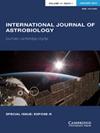在第一个穿越两个星际文明的探测器上
IF 1
4区 物理与天体物理
Q3 ASTRONOMY & ASTROPHYSICS
引用次数: 0
摘要
如果一个太空文明开始了向星际目的地发送探测器的计划,那么第一个到达星际目的地的探测器不太可能是最早的探测器之一,而是一个更先进的探测器。这一结论是基于一个场景得出的,在这个场景中,外星文明(ETC)开始了一项星际计划,在此期间,它发射了越来越复杂的探测器,在整个计划中,探测器的离开速度随着时间的推移而增加。考虑了两个包络线后模型:一个模型中,发射车辆的发射速度随发射时间线性增加,另一个模型则随发射日期呈指数增长。在本文中,考虑的是一个来自非陆地文明的假设探测器到达太阳系。在上述场景中,首次相遇探测器将是在ETC启动星际计划后很久发射的。因此,这样的探测器将是ETC技术相对先进阶段的产物。ETC发射探测器的地点越远,首次相遇探测器与地面技术之间的技术差距就越大。一个可能的分支可能与解释不明飞行现象(UAP)的性质有关。任何UAP的飞行特征是否足够单一,足以与来自遥远ETC的起源相一致?本文章由计算机程序翻译,如有差异,请以英文原文为准。
On the first probe to transit between two interstellar civilizations
If a space-faring civilization embarks on a program to send probes to interstellar destinations, the first probe to arrive at such a destination is not likely to be one of the earliest probes, but one of much more advanced capability. This conclusion is based on a scenario in which an extraterrestrial civilization (ETC) embarks upon an interstellar program during which it launches increasingly sophisticated probes whose departure speed increases as a function of time throughout the program. Two back-of-the-envelope models are considered: one in which the launch velocity of an outgoing vehicle increases linearly with the time of launch, and a second in which the increase is exponential with launch date. In this paper consideration is directed to an hypothesized probe arriving within the Solar System from a non-terrestrial civilization. Within the above scenarios, a first-encounter probe will be one that was launched well after the initiation of an interstellar program by an ETC. Consequently, such a probe would be the product of a relatively advanced phase of that ETC's technology. The more distant the site from which an ETC is launching probes, the greater will be the technology gap between a first-encounter probe and terrestrial technology. One possible ramification may pertain to interpreting the nature of Unidentified Aerial Phenomena (UAP). Are flight characteristics of any UAP singular enough as to be consistent with an origin from a distant ETC?
求助全文
通过发布文献求助,成功后即可免费获取论文全文。
去求助
来源期刊

International Journal of Astrobiology
地学天文-地球科学综合
CiteScore
3.70
自引率
11.80%
发文量
45
审稿时长
>12 weeks
期刊介绍:
International Journal of Astrobiology is the peer-reviewed forum for practitioners in this exciting interdisciplinary field. Coverage includes cosmic prebiotic chemistry, planetary evolution, the search for planetary systems and habitable zones, extremophile biology and experimental simulation of extraterrestrial environments, Mars as an abode of life, life detection in our solar system and beyond, the search for extraterrestrial intelligence, the history of the science of astrobiology, as well as societal and educational aspects of astrobiology. Occasionally an issue of the journal is devoted to the keynote plenary research papers from an international meeting. A notable feature of the journal is the global distribution of its authors.
 求助内容:
求助内容: 应助结果提醒方式:
应助结果提醒方式:


